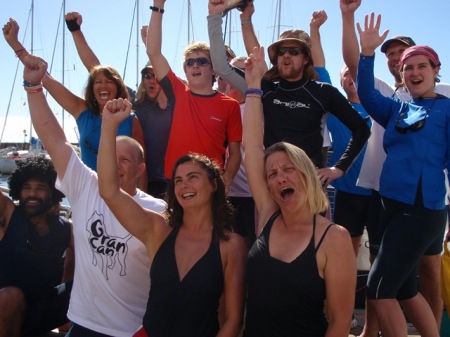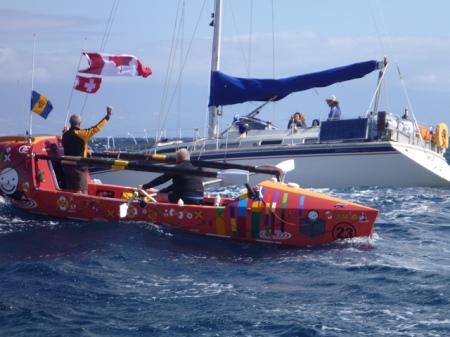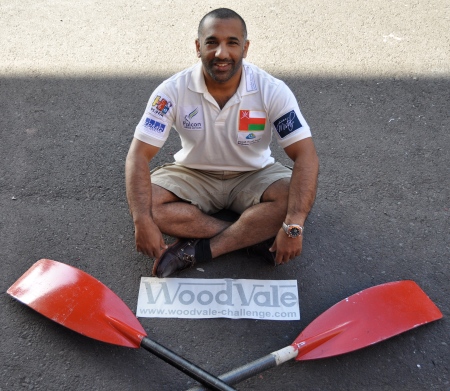08 Feb 2011
The Atlantic Allum Cup is now a week old for Britannia III. After three weeks of delays, and a change of departure location, our support yacht Big Spirit finally counted the starting mark at 12:04 on 31st January 2011.

Image courtesy of Jonathan Briggs
• Simon Chalk (38) Ocean Rower from Totnes – this is his fifth Ocean row
• Guy Griffiths (52) a Business Owner from Cardiff
• Ben Gothard (32) an Accountant from London
• Mike Palmer (45) a Firefighter at Manchester Airport
• Jon Paine (39) an Adventurer from Antigua
• Colin Gray (30) an Events Organiser from London
• Dan Munier (39) an Engineer from Boulder, USA
• Anna Lewis (26) a Graduate Student from Oxford
• Beth Kilbane (40) a writer from Lakewood, USA
• Jennifer Weterings (42) a Health Services Manager from Vancouver, Canada
• Suzanne Pinto (57) a Psychologist from Boulder, USA – the oldest woman ever to row an Ocean
• Roger Gould (55) a Consultant from Twickenham – rowed in the 1997 Atlantic rowing race
• Nabs El-Busaidy (40) a self-employed Adventurer from Oman – the first Arab to row an Ocean
• Shaun Pedley (18) a Boat Builder from Devon – the youngest man ever to row an Ocean
Britannia III and her crew left Puerto de Mogan and the crowds of tourists and supporters behind and made a b-line for the open Ocean. Conditions for Britannia III remained good throughout the week and despite bad sea-sickness Britannia III continued pulling the oars and making good headway.
The conditions across the Atlantic determine that the quickest route when rowing would be to travel south from the Canary Islands. From a lower latitude crews should then pick up stronger trade winds to help push them to the finish. This adds nautical miles to the official distance but, with stronger prevailing conditions crews will make this extra distance up with increased speed.
Britannia III clocked up their fastest “surf” this week at 9.6 knots. The crew, while initially scared, enjoyed the adrenalin rush of surfing down the face of the wave and are wishing for more of these conditions so they can lift their oars from the water and have a break from rowing.
The evening of Day 3 saw Britannia III and the raft An-Tiki coming closer together. Unfortunately our crew didn’t “meet up” for a coffee and some of David’s fresh bread but none-the-less enjoyed travelling at close proximity for a while.
During the last few days of their first week the crew realised that Britannia III wasn’t moving as quickly as they would like through the water. They unpacked and repacked the food (again) in the hope that the boat would stop behaving sluggishly. This had a positive effect as expected and Britannia III averaged 66.4 nautical miles per day for the first week.
Aware that they need to step up the game in order to be in with a chance of breaking the record Britannia III now has a harder job to do as the World Record has just been broken.
Team Hallin, skippered by Charterhouse Rowing Coach David Hosking, broke Leven Brown’s 2007 La Mondiale record by just under a day. The 6-person team arrived in Port St Charles, Barbados yesterday with a new world record time of 31 days, 23 hours and 31 minutes.
Meanwhile, Amigo started on 2nd February 2011 and has been enjoying some good weather. Ole and Serge clocked 2.8 knots on their first day and had a flying start.

Image Courtesy of Ash Chalmers-Stevens
• Ole Elmer (63) a retired Business Owner from Vancouver, Canada – this is his second Ocean Row
• Serge Roetheli (52) a Mountain Guide from Chamonix, Switzerland
Food has been the main topic of conversation for Team Amigo. Ole and Serge took some particular treats in their snack packs and have been looking forward to them each day. In their beautiful boat Amigo, the lightest boat we have ever made and complete with hydraulic steering, the crew have faced heavy seas between La Gomera and El Hierro and as usual there has been some sea-sickness on board. Serge suffered for the first few days but made a speedy recovery and now is back on a full “Serge diet”.
Both Britannia III and Amigo have suffered from the dreaded sore bottoms and blisters on their hands. The first week of these ultra-endurance events is often the hardest. This is when the body hurts most, after these punishing opening days your mind really does take over and dominate the outcome. While the crews are undoubtedly tired, it is the mind that tells you to carry on and blocks out the physical pain. While every time a rower sits down it may hurt, or the first few minutes holding the oar may send pulses through the hands and wrists, the brain ultimately cuts these feelings out and accepts that this is the way it will be. The body truly is a remarkable machine.




 Posted by SultanOfSnow
Posted by SultanOfSnow 




